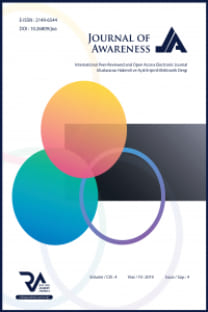DOĞAL AFET DİRENCİNİ ÖLÇMEYE YÖNELİK BİR ANKET ÇALIŞMASININ İLK SONUÇLARI
Doğal afetlere karşı sistematik direnç geliştirebilmek için yerel ölçekte bireysel ve toplumsal eğilimlerin araştırılmasına gereksinim duyulmaktadır. Bu çalışmanın amacı; doğal afet direncini 6 Şubat 2017 Ayvacık-Gülpınar Deprem örneği üzerinde anket tekniği ile yerel afetzedeler üzerinde çalışmaktır. Kapsamı ise ana şokun neden olduğu kayıpları yerel afetzedelerin ne ölçüde onarabildiklerini ölçmeye yönelik planlanan çalışmanın anket hazırlık sürecinde edinilen ilk sonuçları ile sınırlıdır. Araştırma yöntemi olarak, yerel okuma-yazma oranın çok düşük olması nedeniyle yürütücü tarafından açıklamalı soru sorma ve form doldurma olanağı sunan yüz-yüze anket tekniği tercih edilmiştir. Kırk sorudan oluşan deneme anketi soruları; afetzede demografik yapısının çıkarılmasına, depremin kısa ve uzun süreli etkilerinin belirlenmesine ve bu etkilerin ne ölçüde giderildiğine yöneliktir. Bulgular her açıdan irdelendiğinde; deprem sonrasında bireysel olarak sosyal yaşantıya dönüş süresinin ortalama bir yıldan daha fazla olduğu görülmüştür. Ayrıca, bazı afetzede deneklerde uyku bozukluğu ile kendini gösteren psikolojik rahatsızlıkların halen daha devam etmesi; psikolojik açıdan yerel afet direncinin kısmen zayıf olduğu ile açıklanabilir.
Anahtar Kelimeler:
Doğal Afet Direnci, Afetzede, Yüz-Yüze Anket Tekniği, Demografik, Denek
A PRELIMINARY RESULTS OF A SURVEY TO MEASURE NATURAL DISASTER RESILIENCE
In order to develop a systematic resilience to natural disasters, it is necessary to study local individual and social trends. The purpose of this study is to survey natural disaster resilience on local disaster victims of 6 February 2017 Ayvacık-Gülpınar Earthquake using the Face-to-Face Questionnaire Technique. The scope of the study is limited to the preliminary results obtained from the questionnaire preparation process in order to measure to what extent local disaster victims recover their losses caused by the main shock. As the survey method, the face-to-face questionnaire technique, offering the authorized researchers the opportunity to explain the questions and fill out the form due to the low local literacy rate, is preferred. A trial forty-questions questionnaire is to determine to the demographic structure of group of the disaster victims and the short and long term effects of the earthquake. Through examination of findings in every aspect, to return to normal social life the average time is more than one year after the earthquake. In addition, ongoing unusual health problems manifested by insomnia diagnosed on some subjects can be explained by the fact that local psychological disaster resilience is partially weak.
Keywords:
Natural Disaster Resilience, Disaster Victim, The Face-to-Face Questionnaire Technique, Demographic, Subject,
___
- AFAD (T.C. Başbakanlık Afet ve Acil Durum Yönetimi Başkanlığı) Açıklamalı Afet Yönetimi Terimleri Sözlüğü, 2014, ISBN 978-975-19-6271- 3.
- CHISTOPHER, M. and PECK, H., 2004, Building the Resilient Supply Chain, International Journal of Logistics Management, 15 (2), 1-13.
- COMBAZ, E., 2014, Disaster Resilience: Topic Guide, GSDRC International Development Department College of Social Sciences, University of Birmingham.
- CUTTER, S. L., 2016, The Landscape of Disaster Resilience Indicatorsin the USA, Natural Hazards, 80(2), 741-758.
- ÇAM, O. ve BÜYÜKBAYRAM, A., 2017, Hemşirelerde Psikolojik Dayanıklılık ve Etkileyen Faktörler, Psikiyatri Hemşireliği Dergisi, 8(2), 118-126.
- ER, G., 2009, Ailesi Parçalanmış Olan İlköğretim İkinci Kademe Öğrencilerinin Akademik Sağlamlık Düzeylerinin Bazı Değişkenlere Göre Yordanması, Yüksek Lisans Tezi, Ege Üniversitesi.
- GASPARINI, P, MANFREDI, G. and ASPRONE, D, 2014, Resilience and Sustainability in Relation to Disasters: A Challenge for Future Cities: Common Vision and Recommendations, Springer Briefs in Earth Sciences.
- GİZİR, C. A., 2004, Akademik Sağlamlık: Yoksulluk İçindeki Sekizinci Sınıf Öğrencilerinin Akademik Başarılarına Katkıda Bulunan Koruyucu Faktörlerin İncelenmesi, Doktora Tezi, Orta Doğu Teknik Üniversitesi.
- KARASAR, N., 2010, Bilimsel Araştırma Yöntemi, 21. Baskı, Nobel Yayın Dağıtım, Ankara.
- MANYENA, S. B., 2006, The Concept of Resilience Revisited, Disasters Homepage, 30(4), 434-450.
- MIZRAK, S., 2017, Afete Dirençli Toplum Oluşturmak için Bireysel Yeterlilikler, Yüksek Lisans Tezi, Çanakkale Onsekiz Mart Üniversitesi.
- ÖĞÜLMÜŞ, S., 2001, Bir Kişilik Özelliği Olarak Yılmazlık, 1. Ulusal Çocuk ve Suç Sempozyumu: Nedenler ve Önleme Çalışmaları, 29-30 Mart 2001, Ankara.
- PLOUGH, A., FIELDING, J. E., CHANDRA, A., WILLIAMS, M., EISENMAN, D., WELLS, K. B., LAW, G. Y., FOGLEMAN, S. and MAGANA, A., 2013, Building Community Disaster Resilience: Perspectives from Large Urban County Department of Public Health, American Journal of Public Health, 103(7), 1190 – 1197.
- PONOMAROV, S. Y. and HOLCOMB, M., 2009, Understanding the Concept of Supply Chain Resilience, The International Journal of Logistics Management, 20(1), 124-143.
- SPSS, 2018, https://www.ibm.com/software/tr/info/trials/#all
- SUTCLIFFE, K. M., and VOGUS, T., 2003, Organizing for Resilience, Positive Organizational Scholarship, San Francisco: Berrett-Koehler, 7, 94-110.
- TERZİ, Ş., 2006, Kendini Toparlama Gücü Ölçeğinin Uyarlanması: Geçerlik ve Güvenirlik Çalışmaları, Türk Psikolojik Danışma ve Rehberlik Dergisi, 26(3), 77-86.
- TOBIN, G., GASPARINI, P., and ASPRONE, D., 2012, Resilience and Sustainability in Relationto Disasters: A Challenge for Future Cities, UN Habitat-World Urban Forum 6, Naples.
- UKaid, 2011, Defining Disaster Resilience: A DFID Approach Paper. 20.
- ISSN: 2149-6544
- Başlangıç: 2016
- Yayıncı: Rating Academy
Sayıdaki Diğer Makaleler
AKSARAY AHŞAP İŞÇİLİĞİ VE OYMA SANATI
AKSARAY’DA UNUTULAN BİR GELENEK ‘‘DÖVME SANATI’’*
Esra YALÇIN, Ahmet UÇAKTÜRK, Tülay UÇAKTÜRK
“UMUT” TELKİN EDEN HÜSN-İ HAT LEVHALARI*
KÜRESEL ENERJİ TALEBİNDE KONVANSİYONEL OLMAYAN KAYNAKLARIN ROLÜ
PLAZMA ATEROJENİK İNDEKSİN DİYABETES MELLİTUS TİPLERİ ARASINDA KARŞILAŞTIRILMASI
Ercan AKŞİT, Özge TURGAY YILDIRIM, Ayşe HÜSEYİNOĞLU AYDIN, Fatih AYDIN
CEZAEVİ KÜTÜPHANELERİ: KIRŞEHİR AÇIK CEZA İNFAZ KURUMU KÜTÜPHANESİ ÖRNEĞİ
